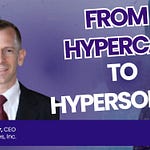About James Boyd
James Boyd is the archetype of a mission-driven founder. Born in California but raised in the UK, his trajectory changed completely on September 11, 2001, when he was a Stanford computer science student. Instead of following his peers into consulting or investment banking, Boyd made the contrarian decision to enlist in Army Special Forces—a choice that would define his entire career.
Boyd was in the First Special Forces Group for about three years. It was during these deployments that he experienced firsthand the friction between cutting-edge intelligence systems and the analog processes that dominated day-to-day military operations. This experience led him to Palantir, where he spent nearly seven years building and deploying data analytics platforms across special operations units.
The combination of Stanford computer science education, Special Forces operational experience, and Palantir's high-velocity startup culture created a unique skill set: deep technical capabilities paired with intimate understanding of military operations and bureaucratic navigation. This intersection would prove invaluable when founding Adyton.
About Adyton
Adyton was founded in early 2020 with a simple but powerful thesis: while defense organizations had invested heavily in enterprise systems and data analytics, the actual warfighters—the people doing maintenance, training, and operations—remained trapped in analog processes using paper notebooks, clipboards, and manual data entry.
The company's flagship product, Adyton Operations Kit (AOK), transforms these analog workflows into seamless digital experiences optimized for mobile devices. Rather than requiring new government-furnished equipment, AOK leverages the smartphones that service members already carry, addressing everything from personnel accountability to digital asset management to training coordination.
Adyton's growth trajectory has been impressive: 500% growth in 2024, deployment across 39 of 59 Army Brigade Combat Teams, adoption by seven Special Forces groups, and recent expansion to multiple Navy aircraft carriers. The company achieved this scale through organic, bottom-up adoption—end users demanding the product rather than top-down procurement mandates.
Key Takeaways
1. Bottom-Up Adoption can be a Massive Catalyst
Boyd's decision to target end users (E-3s, E-4s, E-5s) rather than program offices was initially seen as unconventional. Traditional defense contractors focus on decision-makers and budget holders. However, by solving real pain for actual users, Adyton created organic evangelists who pulled the product through the organization. When a Navy ship's executive officer found AOK through the Apple App Store and onboarded hundreds of sailors within days, the fuse was lit.
2. You’ll know you’re getting close to Product-Market Fit when you get those visceral user reactions
The moment Boyd knew Adyton had achieved product-market fit wasn't through metrics or surveys—it was when a soldier in an Army chapel saw their digital asset management demo and exclaimed "F my life!" out loud. And it was a goooood thing. This solider recognized immediately how much time he was about to save. That EMOTION - not the efficiency stats - was the moment James knew.
3. Acquisition Fluency Is a Core Competency
Boyd's native understanding of defense acquisition processes—SBIR phases, TACFI programs, ATOs, RMF certification, contracting vehicles—enabled Adyton to navigate bureaucratic requirements that often kill promising technologies. The company used a "kitchen sink" approach, leveraging multiple acquisition pathways simultaneously rather than betting on a single route to market. This acquisition literacy, learned through Boyd's military and Palantir experience, became a sustainable competitive advantage.
4. Personal Devices Unlocked Enterprise Transformation
While most defense tech companies focused on government-furnished equipment, Adyton bet on BYOD (Bring Your Own Device) capabilities. This decision reflected a beautifully simple insight: service members already carry the most powerful computers ever created in their pockets. By enabling secure, compliant workflows on personal devices, Adyton eliminated the deployment friction that traditionally limited military software adoption.
5. Mission-Driven Culture Enables Long-Term Resilience
Boyd's emphasis on culture and values isn't just startup rhetoric—it's survival strategy in defense tech. The space requires sustained effort through bureaucratic obstacles, lengthy sales cycles, and technical challenges that would break teams lacking deep conviction. As Boyd noted, "there'll be a bit of a shakeout" in defense tech, and only companies with genuine grit and alignment around mission will persevere. Culture becomes the differentiator when facing the inevitable obstacles of changing entrenched systems.
Follow James Boyd: https://www.linkedin.com/in/james-alexander-boyd/
Learn more about Adyton: https://www.adytonpbc.com/
Subscribe for more Crossing the Valley: www.valleycrossers.com











